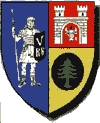Lupșa
Lupșa | |
|---|---|
 Lupșa Orthodox monastery | |
 Location in Alba County | |
| Coordinates: 46°22′N 23°12′E / 46.367°N 23.200°E | |
| Country | Romania |
| County | Alba |
| Government | |
| • Mayor | Dănuț-Vasile Bârzan (PSD) |
| Area | 103.6 km2 (40.0 sq mi) |
| Elevation | 568 m (1,864 ft) |
| Highest elevation | 1,350 m (4,430 ft) |
| Lowest elevation | 550 m (1,800 ft) |
| Population (2021-12-01)[1] | 2,732 |
| • Density | 26/km2 (68/sq mi) |
| Time zone | EET/EEST (UTC+2/+3) |
| Postal code | 517410 |
| Vehicle reg. | AB |
Lupșa (German: Wolfsdorf; Hungarian: Nagylupsa) is a commune located in Alba County, Transylvania, Romania. It is composed of 23 villages: Bârdești, Bârzan, Curmătură, După Deal, Geamăna, Hădărău, Holobani, Lazuri, Lunca, Lupșa, Mănăstire, Mărgaia, Mușca, Pârâu-Cărbunări, Pițiga, Poșogani, Șasa, Trifești, Văi, Valea Holhorii, Valea Lupșii, Valea Șesii and Vința.
The commune is located in Țara Moților, on the slopes of Muntele Mare to the north and the Metaliferi Mountains to the south. The area has a specific mountain relief developed on crystalline schists and metalliferous rocks. It ranges in height between 550 m in the meadows of the Arieș River (which traverses it for 19 km) to 1,350 m in Geamăna. Lupșa is on the DN 75 Turda–Câmpeni road, 95 km from Alba Iulia, the county seat, 15 km from the city of Câmpeni, and 9 km from Baia de Arieș, the nearest town.
In 1978, the communist regime opened the Roșia Poieni copper mine near Geamăna, which at the time had over 1000 residents. In 1986, production from the mine caused the formation of a muddy lake, which gradually submerged almost the entire village. By 2015, at most 15 people remained. The main objective is a partly submerged church which has become a tourist attraction.[2]
References



